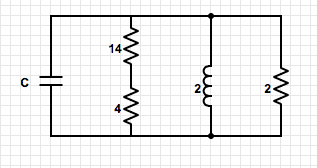| Line 28: | Line 28: | ||
<math>b^2 - 4c = 0</math><br /> | <math>b^2 - 4c = 0</math><br /> | ||
The next step would be to simplify the circuit as shown in the image below. Once simplified it becomes a parallel RLC circuit where we know:<br /> | The next step would be to simplify the circuit as shown in the image below. Once simplified it becomes a parallel RLC circuit where we know:<br /> | ||
| − | <math> b = \frac{1}{RC} | + | <math> b = \frac{1}{RC}</math> and <math>c = \frac{1}{LC}\\</math> |
[[File:ECE201P6_1.png|500px|center]] | [[File:ECE201P6_1.png|500px|center]] | ||
| Line 35: | Line 35: | ||
Once we know b we can use the critically damped equation to solve for C.<br /> | Once we know b we can use the critically damped equation to solve for C.<br /> | ||
<math>\begin{align} | <math>\begin{align} | ||
| − | 8^2 - \frac{4}{2C} = 0 | + | 8^2 - \frac{4}{2C} = 0 |
| − | 64 = \frac{2}{C} | + | 64 = \frac{2}{C} |
| − | C = \frac{1}{32} | + | C = \frac{1}{32} |
\end{align} | \end{align} | ||
</math> | </math> | ||
Revision as of 14:47, 2 May 2015
Critically Damped Practice
Practice question for ECE201: "Linear circuit analysis I"
By: Chinar Dhamija
Topic: Critically Damped Second Order Equation
Question
Find the value for C that will make the zero input response critically damped with roots at -4.
Answer
For a response to be critically damped we know that:
$ b^2 - 4c = 0 $
The next step would be to simplify the circuit as shown in the image below. Once simplified it becomes a parallel RLC circuit where we know:
$ b = \frac{1}{RC} $ and $ c = \frac{1}{LC}\\ $
Since the root was given to be -4 we can find b.
$ \frac{-b}{2} = s<\math> so we get: <math>\frac{-b}{2} = -4\\ therefore b = 8 $
Once we know b we can use the critically damped equation to solve for C.
$ \begin{align} 8^2 - \frac{4}{2C} = 0 64 = \frac{2}{C} C = \frac{1}{32} \end{align} $
Questions and comments
If you have any questions, comments, etc. please post them below
- Comment 1
- Answer to Comment 1
- Comment 2
- Answer to Comment 2



